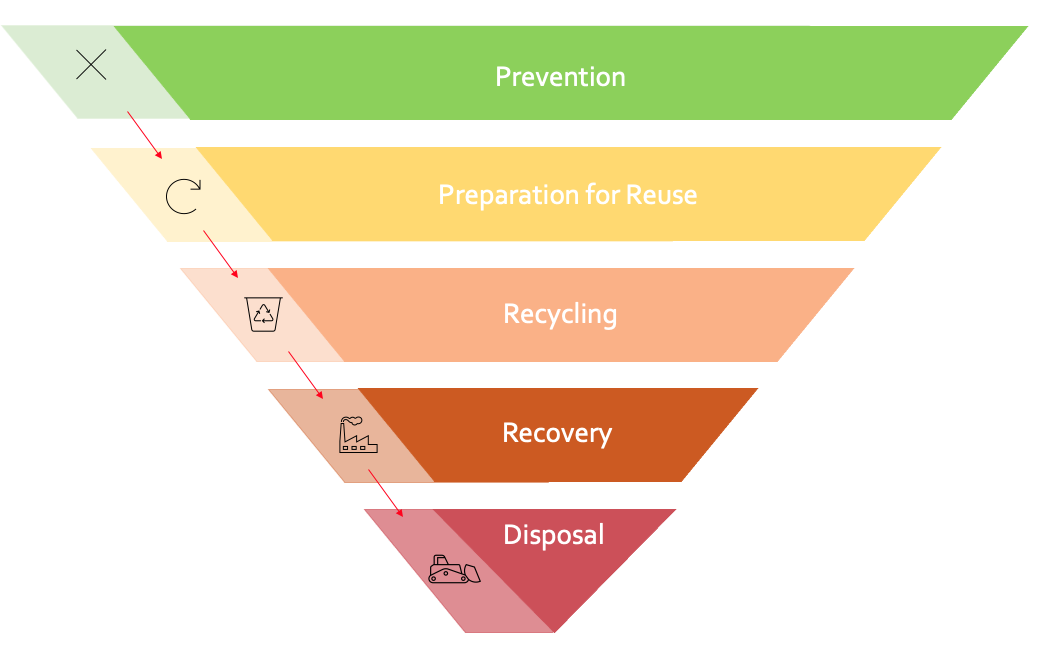The circular economy and its relation to waste management have become hot topics in recent times. One can read about the meaning of a circular economy and how companies can integrate it into their operations in this article. Today we want to take a step back and take a closer look at waste management itself. We all produce waste and dispose of it every day. However, there is so much more to waste management than just disposal. In this article, we will take a closer look at waste management and show simple and easy-to-implement options for companies and how to integrate them efficiently into their operations.
Waste management at the legal level
In 2008, the European Union adopted the Waste Framework Directive with the aim of protecting the environment and ensuring human health. This directive is implemented by national laws in each European member state. In Austria, the “Abfallwirtschaftsgesetz” (AWG 2002) fulfills this purpose. Each member state can determine its own procedure to meet the requirements. The AWG 2002 contains all the requirements, objectives and measures of Austrian waste legislation. It also outlines the waste hierarchy, that prioritizes the preferred options for managing waste and serves as a framework for developing measures and strategies to be used in legislation and policy. The hierarchy is presented in reverse, with the top level representing the preferred option and the bottom level only as a last resort.
Waste management & waste hierarchy
The waste hierarchy is divided into 5 levels (see figure):
- Prevention: Do not create waste
- Preparation for reuse: testing, cleaning, repairing
- Recycling (=material recovery): Reprocessing for the original purpose or for other purposes; Material property remains intact
- other recovery: energy recovery and other material recovery
- Disposal: everything that is not recovery (incineration without sufficient energy use, landfilling of residual materials)
This hierarchy sequence must always be followed, and deviation from the sequence should only occur in exceptional cases where justified. For instance, waste processing at a lower level may be more technically or economically viable. However, such cases should be the exception rather than the rule.
The waste hierarchy is not only applicable at the legislative level but can also serve as a useful guideline for waste management in companies. Implementing effective waste management practices can have several, such as reducing environmental impacts, saving costs, increasing efficiency, and ensuring compliance with waste legislation.
Examples of waste hierarchy
The following examples illustrate how the waste hierarchy can serve as a starting point for effective operational waste management:
- Preventing waste in the first place is the best approach, as no waste is always preferable. This can be achieved by using reusable products or by minimizing packaging materials when purchasing goods.
- Products and items can break down over time. Instead of disposing of them directly, consider reusing them. This may involve repairing broken utensils.
- Sometimes the products that have accumulated cannot be reused. In this case recycling is the next step. It is crucial to separate and dispose of the waste properly. An example of this the collection of waste paper. Waste paper can be recycled into new paper products through separate collection and correct disposal. However, it is essential to provide sufficient and appropriate waste containers for separate collection in the company.
- If the waste produced cannot be reused or recycled, energy recovery can be considered as an option, such as using it as fuel. In manufacturing companies, waste can be used to generate heat or electricity for production. Nevertheless, this approach is not suitable for all industries.
- If none of the above options are viable, disposal of the waste should be considered as a last possible option. However, it is necessary that the waste is separated and disposed of properly.
Next steps
Improving waste management requires the cooperation of all employees, which can be achieved through awareness-raising. By involving employees in the process, comapnies can develop a waste management guideline that addresses environmental concerns and cost savings. It is important that everyone follows these guidelines and sets a good example. Regular feedback sessions can generate new ideas and help implement improving the system.
Businesses can take their waste management to the next level by developing a waste management concept specifically tailored to their operations.

